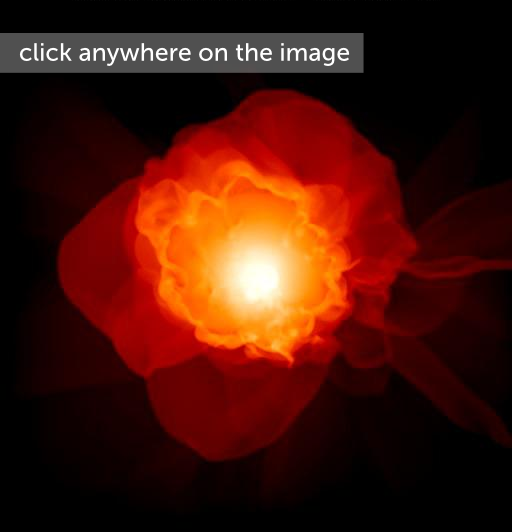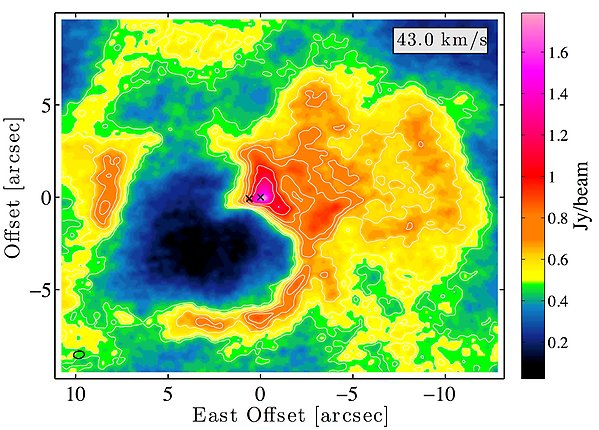Stellar winds
Dynamics and 3d Structure
Most stars, but especially luminous ones, show continuous outflows of gas from their surfaces. These flows are called stellar winds, of which the solar wind is a well-known example. The mechanisms that drive gas away from stars are a matter of intense research, combining advanced computer simulations and observations obtained with the latest generation of ground- and space-based telescopes.
We study the winds of a type of cool luminous giants called Asymptotic Giant Branch (AGB) stars. These winds are presumably triggered by radiative acceleration of microscopic solid particles – so-called dust grains – that form in the extended stellar atmospheres. Cool giant stars emit radiation corresponding to about 5000 to 10000 times the solar luminosity, and the dust grains efficiently absorb and scatter the light emitted by the star. Since the photons are mostly directed away from the star, the dust is pushed outwards when interacting with the stellar radiation. The dust grains are embedded in the gas from which they form, and when the gas is accelerated outwards it drags the gas along, away from the star into space. Through this process, the surrounding interstellar medium is enriched with newly-produced chemical elements that are crucial for building Earth-like planets and living organisms.
Our detailed numerical models follow the flow of matter from the convective, pulsating interior of the star, through the stellar atmosphere where strong shock waves lift gas to distances where dust grains can form, and into interstellar space. Recently, observations have revealed complex structures in the atmospheres and winds, reflecting effects of stellar pulsation, convection and dust. We are developing advanced 3D “star-in-a-box” models to study the formation of these structures.

3D star-in-a-box model of a cool giant. The figure shows a snapshot of the gas density, plotted for a slice centred on the stellar core (brighter colours indicate higher densities). The width of the box is about 4 stellar radii, the stellar radius is about 400 solar radii. The movie shows how giant convection cells trigger shock waves in the stellar atmosphere, lifting material far above the stellar surface (bright red blobs moving outwards), to distances where dust grains can form. Click on the image to open the video (opens in a new tab). Image: B. Freytag
Properties of stardust
The dust grains, which play an important role in triggering stellar winds of cool giants reveal their presence by affecting the light emitted by the star. They produce characteristic bands in the infrared part of the spectrum, which allow us to identify the materials that they consist of. Depending on the chemical composition of the star, two types of grains are probably responsible for accelerating the winds: carbon grains or silicate grains. The former are basically made out of the same material as coal or soot and therefore very efficient at absorbing light. The latter are more transparent but are very efficient at scattering photons if the grains grow to sizes of 0.1-1.0 micrometre in the stellar atmosphere. These types of materials are not only found in stellar atmospheres and winds, but also throughout the solar system, in the dusty tails of comets, in meteorites, and in the crusts of the terrestrial planets. In some cases, it has been possible to identify original grains of stardust (so-called pre-solar grains) in meteorites.

ALMA image of the CO gas around the well-known binary cool giant star Mira (o Cet) and its companion (the positions of the two stars are marked by crosses). The heart shape is created by the fast wind of the companion star (to the left) blowing a bubble in the dense slower wind of the giant star (to the right). Image: S. Ramstedt et al. 2014
Cool giant stars in binary systems
When a cool luminous giant is in a close binary system, the companion star will have a strong influence in shaping the wind. It has been suggested that a close companion star is required to explain the different structures seen among planetary nebulae: the next stage of stellar evolution. If the companion is a white dwarf and accretes enough matter from the wind of the giant star, it will eventually explode as a supernova. This type of supernova, Type Ia, is used to measure distances and they have been instrumental for measuring the expansion of the Universe. Neither the formation of planetary nebulae, nor of Type Ia supernovae, is well understood. Through recent improvements in the sensitivity and resolution of astronomical instruments, high-fidelity 3D images of these objects can be obtained. The detailed images also contain information about gas velocities and they can be used to constrain 3D models of the interaction between a nearby companion star and the wind of the giant star. By studying the likely progenitor systems of planetary nebulae and Type Ia supernovae, we try to understand the important physical processes during their formation, i.e. the wind mechanisms and the accretion efficiency.
Contact
Contact
- Head of Division
- Eric Stempels
